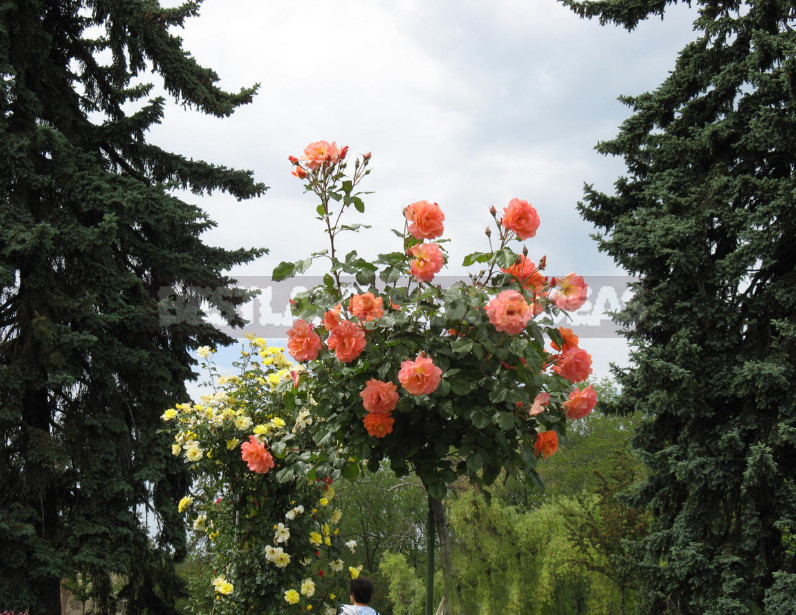
Stamp roses are not an independent garden group — rather it is a reception of garden art for a spectacular demonstration of the beauty of roses. It is not known what enthusiast and fan of roses came up with the idea to raise it on a pedestal, but believe that the first roses were grown in the late XVIII century by grafting a kidney on Rosa canina.
The fashion for stamp roses was changeable: in other times, stamp alleys were the pride of the gardens, and in others such beauty was found a boring solution. Anyway, today no one significant rose garden, the world is not without Stamp roses
In any garden, a stamp rose in full glory becomes the center of attention, and other garden plants find it difficult to compete with it. Owners of stamp roses need to maintain their high decorative status with careful care.
Trunk roses: what they are
Stem roses are divided by the height of the trunk (from the beginning of the roots to the place of vaccination, excluding the crown), which determines the possibility of their use in gardening:
- miniature trunk(0.40-0.45 m);
- semi-trunk(0,7-0,8 m);
- trunk(0,9-1,1 m);
- weeping (cascade) roses (1,2-1,7 m).
On miniature strains often vaccinated miniature roses, and sometimes compact varieties of groundcover roses. Semi-stem roses mainly serve to demonstrate the picturesque and abundant flowering roses floribunda, and stem to everyone’s delight are hybrid tea roses. Weeping stem roses are obtained from ground cover and climbing roses, especially spectacular cascades of roses type Rambler.
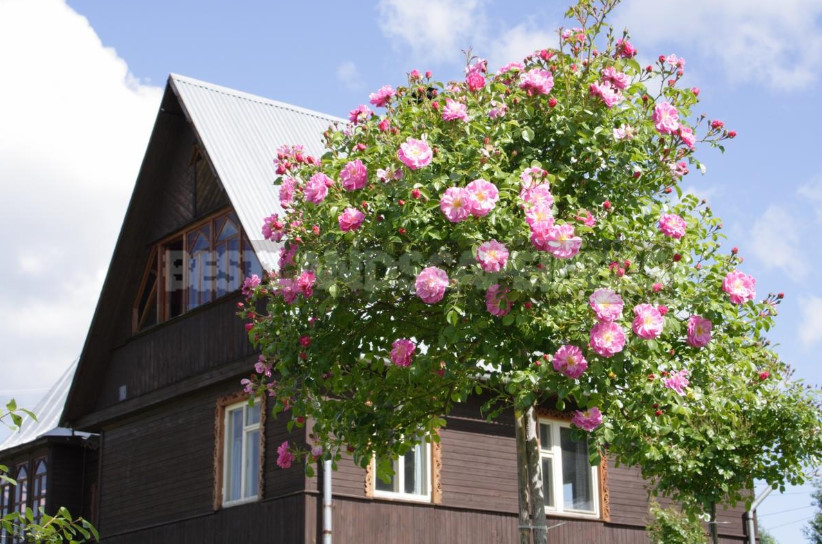
In Stamp rose no minor details. The trunk should be smooth, grafted variety have an attractive habit (for example, bushes with straight shoots are inappropriate on the trunk), excellent quality of the flower, delicate aroma, decorative and healthy leaves. A necessary condition-abundant and long flowering, preferably without long pauses.
When buying a stamp rose in garden centers, unfortunately, it is impossible to obtain detailed information, only a specialist, based on the name of the grafted varieties and the quality of the seedling, can judge its decorative possibilities.
Selection of seedlings
Stamp roses are better to buy in containers, as they are particularly sensitive to moisture loss. Choose direct strains with a diameter of at least 1 cm (for weeping forms — about 2 cm), without signs of damage. The crown should be formed and have several strong branches. In the future, you can achieve uniformity of the crown, if the budding of two kidneys was successful. In some large European nurseries on weeping strains vaccinate even three kidneys. You should not buy strains with one grafted kidney-as a rule, it is not possible to form an attractive crown.
Let me explain this simple verification mechanism. Choose any escape from the crown of the trunk and find its base — a place of budding. If all shoots of the crown are only from the kidneys, so the budding of the other kidney failed. Choose a trunk, where 2 kidneys are occluded, and from opposite sides relative to the axis of the trunk. Other options will always be worse.
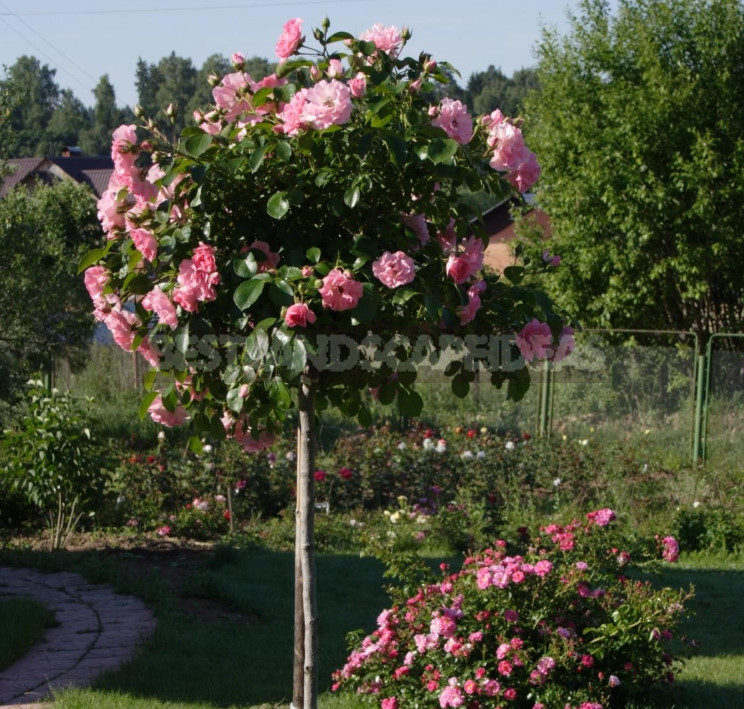
When buying a seedling with a closed root system, one should proceed from the requirement that the height of the container is not less than 25 cm, the plant is easily removed, and the earthen lump is permeated with roots. There may be cases when the strains are only planted in containers the day before, and this option guarantees some problems. Dry or waterlogged soil, the presence of weeds or moss – signs of poor care.
Stem roses with open roots during engraftment will require significant attention. Sprouted buds, and even more so-growing young shoots of seedlings with bare roots signal a loss of quality, when planting they will have to be cut. If you do not have experience, it is better to postpone the purchase until the next successful case.
Rules for planting roses
Stamp roses are planted in the spring. The sapling from the container and planted in a hole larger than the soil ball, replacing the temporary support for a reliable count. Remember that the garden center roses in pots watered daily, so the first 3-4 weeks water them often. By planting stem roses with bare roots should be taken more carefully.
Sequence of operations
1. Before planting roses in the pit is set strong support, the upper part of which should be slightly below the crown.
2. Rose planted without sinking at a distance of about 10 cm from the support, providing a slight slope in the direction of bending in winter shelter.
3. You should also pay attention to the bend in the base of the trunk: it should be on the side opposite to the slope. This point is always difficult and requires clarification. Imagine that this escape did not grow strictly vertically, but at some angle relative to the surface of the earth. When it was straightened and secured to the peg, a bend formed at its base. If you look at the trunk, and this bend, for example, on the left, then bend down the trunk at the shelter to the right.
Remember the landmark when landing (for example, towards your gazebo or Bush of white lilac, etc.), otherwise in the fall you will return to this problem again, and its solution will be even more difficult.

4. After planting and compacting the soil, the trunk is tied to the support with loops in the form of eight at the base of the crown, in the middle and in the lower part of the trunk.
5. Carry out pruning of the crown in accordance with the belonging of the variety to the garden group of roses.
6. After landing on a period of healing the crown needs to be protected from drying out. To this end, the place of budding and shoots can be overlaid with moistened moss or cotton (even paper) and tied with lutrasil. Before swelling and germination of the kidneys (about 10 days), it is necessary to ensure that the protective material is always wet. Expose the crown after engraftment is better on cloudy days or in the evening. If you can not save all the kidneys, you have to cut the dried tops.
7. In the future, when the roses get stronger and grow, will have to put a support for the crown, especially drooping and heavy. Special holders are sold for this purpose. I use a metal cross-piece of pipe, on which uniformly distributed, for example, the scourge of the Rambler.
Tips for caring for stamp roses
Care for roses is carried out on the principle of belonging grafted varieties to garden groups of roses and contains the full range of agricultural activities. Particular attention should be paid to pruning, because it primarily determines the decorative stamp roses.

The main pruning of all types of roses, with the exception of single flowering roses type Rambler, held in the spring. Once flowering roses Rambler cut immediately after flowering, otherwise the crown is thickened and reduced flowering. With this group of roses can achieve the desired shape of the crown, but many experienced gardeners believe that the most effective natural. Remontant varieties of this group (’Super Dorothy‘ and ’Super Excelsa’) are cut as large-flowered climbing roses.
It is necessary to pay attention to another feature of stem roses: shoots of rootstock may appear throughout the height of the trunk. It is necessary to periodically inspect the trunk, especially in the places of the garter and parts hidden by the crown. As the appearance of unnecessary shoots they just break out.
You can do it: how to grow a stamp rose
Growing Stamp roses-quite difficult, and most importantly — a long occupation. It takes at least 4 years to grow a quality seedling. Despite some difficulties, each enthusiast is able to grow their own pride of their own garden. Of course, I will not vouch for the quality and durability of such a trunk, but in any case, it will bring you joy.
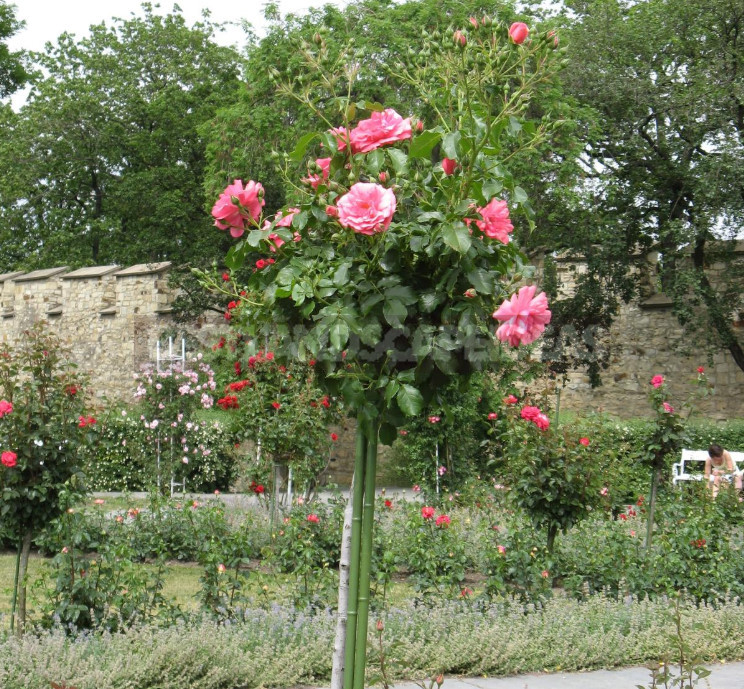
If some of your grafted roses (of course, not very old) died, and from root spring appeared strong shoots rootstock, leave the most a powerful of them, and the rest cut have root a neck. Under favorable conditions, the escape of wild rose can grow and have time to lignite to the selected height of the trunk, but most likely, your task will be to keep it until next summer.
With the technique of budding read the literature. Practice in cutting the shield with a kidney on any branch of the rose.
When you use the special budding knife. In early August, guide the budding T-shaped incision on the rootstock two kidneys (on opposite sides, spacing, height about 3 cm). After 2-3 weeks, check the survival rate of kidneys, and you are on your way to success.
In winter, bend it down, pre-cut, leaving above the grafted kidneys about 10 cm of the trunk, and easily cover for the winter. In the spring, after the snow melts and the soil warms up, make a trim at a distance of 1 cm from the upper kidney and the cut surface must be well smeared with the usual garden brew. Do not use modern means, through them slice “cries”.
Be sure to straighten the trunk and tie it to the support in several places. If the strain turns out to be uneven, it will later manifest as an irreparable defect. In order to avoid risks, sprouting buds from drying out protect strapping from lutrasil.
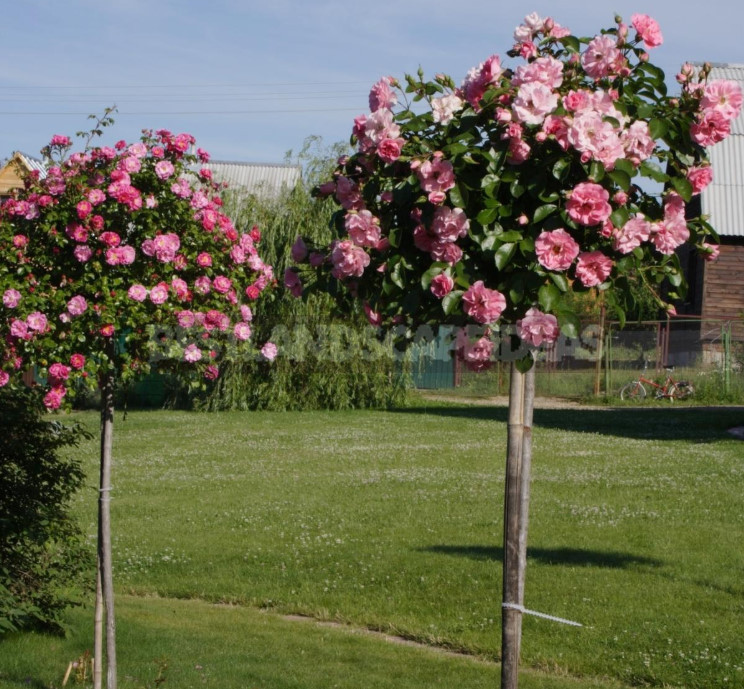
Remains the most pleasant operation – the formation of the crown. Young shoots pinch after 4 leaves, and the first buds are removed. At the end of summer you will see your trunk blooming.



